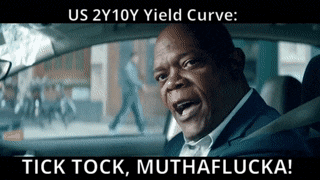|
Uh-Oh — Everybody, stay calm… no need to panic… it’s just the inversion of the 2- and 10-year treasury yields… it’s not like that almost guarantees a recession or anything, right??

Well, kinda. While we still shouldn’t panic yet, the 10-year treasury yield and the 2-year treasury yield officially inverted yesterday. It’s not that an inversion guarantees a recession, but “historically, a recession has not happened without an inversion,” says global macro strategist Ben Emons. Nice and calming, right?
No, of course not, so what does this mean? An inversion of shorter and longer-term treasury yields is a signal of investors’ doubt in long-term economic growth, hence the higher return for short-term products. In theory, longer-term yields comprise shorter-term yields while incorporating other time-induced risks like future changes in interest rates.
That means that the 10-year yield should be roughly equivalent to holding ten 1-year, or, in this case, five 2-year notes. So, this is essentially investors’ way of saying they expect growth to slow in the long term. In layman’s terms, it’s a big “f*ck you” to JPow.
But let’s get technical for a second. First, it’s important to recognize inversions have been present since October, when 20-year yields surpassed 30-year yields. Since then, several other inversions have occurred, including the 7- and 10-year and the 5- and 10-year in just the past month alone. So while yield curve inversions aren’t new to our current market, the inversion of the 2- and 10-year yields are.
And when it comes to recession predicting, it just so happens it’s the 2- and 10-years that matter. 6 out of our last 6 recessions have been preceded by a 2- and 10-year inversion. But for its predictive power to truly come to fruition, history says the inversion has to remain for at least a full quarter (aka 3 months, aka 90 days). So no need to panic yet, but the countdown is officially on. If nothing changes before late June, we riot.

Fortunately, investors have (allegedly) been mentally prepared for this. Rate hikes tend to lead to a compression in the spread of short-term and long-term yields. Both short and long-term yields tend to rise, but short-term yields tend to rise more as longer date issues inherently carry more interest rate risk. This time, the 2-year yield rose wayyyy more than the 10-year, hence the inversion.
TL;DR: Mr. Market is terrified of Mr. Inversion. He can usually deal with Mr. Invrsion for a while, but if he hangs around for too long, that’s a fight on sight. Fingers crossed, apes.
|
Sapiente est blanditiis laborum vel. Est doloremque molestiae doloribus in. Inventore in laboriosam sed autem repudiandae voluptas.
Quisquam deserunt quod non et itaque ducimus facere. Fuga nostrum illo odio voluptas.
Qui eaque ad tenetur provident. Tenetur sequi et ut. Dolor atque ut ut et vitae non.
Consequatur est dolores vero sit illum eum. Voluptas debitis omnis quas voluptatem doloremque.
See All Comments - 100% Free
WSO depends on everyone being able to pitch in when they know something. Unlock with your email and get bonus: 6 financial modeling lessons free ($199 value)
or Unlock with your social account...